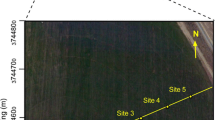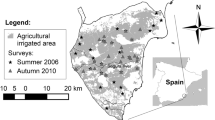Abstract
Soil water content (θ) measurement is vital for accurate irrigation scheduling. Electromagnetic induction surveys can be used to map spatial variability of θ when other soil properties are uniform. However, depth-specific θ variations, essential for precision irrigation management, have been less investigated using this method. A quasi-2-dimensional inversion model, capable of inverting apparent soil electrical conductivity (ECa) data to calculate estimates of true electrical conductivity (σ) down the entire soil profile, was developed using ECa data collected by a multi-coil Dualem-421S sensor. The optimal relationships between σ and volumetric water content (θv) were established using all coil arrays of the Dualem-421S, a damping factor of 0.04, an initial model of 35 mSm−1, and with ten iterations (R2 = 0.70, bias = 0.00 cm3cm−3, RMSE = 0.04 cm3cm−3). These relationships were then used to derive soil profile images of these properties, and as expected, θv and σ follow similar trends down the soil profile. The derived soil profile images for θv have potential use for irrigation scheduling to two ECa-derived soil management zones under a variable rate irrigation system at this case study site. They reflect the intrinsic soil differences that occur between texture, texture transitions and drainage characteristics. The method can also be used to guide placement of soil moisture sensors for in-season monitoring of spatio-temporal variations of θv. This soil imaging method showed good potential for predicting 2D depth profiles of soil texture, moisture and drainage characteristics, and supporting soil, plant and irrigation management.











Similar content being viewed by others
References
Allen, R., Pereira, L., Raes, D., & Smith, M. (1998). Crop evapotranspiration-guidelines for computing crop water requirements-FAO irrigation and drainage paper 56. Rome, Italy: FAO.
Aragon, B., Houborg, R., Tu, K., Fisher, J. B., & McCabe, M. (2018). CubeSats enable high spatiotemporal retrievals of crop-water use for precision agriculture. Remote Sensing, 10(12), 1867.
Charlesworth, P. (2005). Irrigation insights no. 1-soil water monitoring. National program for irrigation research and development (2nd ed.). Melbourne, Australia: CSIRO Publishing.
Claydon, J. (1989). Determination of particle size in fine grained soils—pipette method. DSIR division of land & soil sciences technical record LH5. Retrieved September 28, 2016 from https://www.landcareresearch.co.nz/resources/laboratories/soil-physics-laboratory/services-offered/tests
Clothier, B., & White, I. (1981). Measurement of sorptivity and soil water diffusivity in the field 1. Soil Science Society of America Journal, 45(2), 241–245.
Clothier, B., Scotter, D., & Kerr, J. (1977). Water retention in soil underlain by a coarse-textured layer: theory and a field application. Soil Science, 123(6), 392–399.
Cook, F. J., Lilley, G. P., & Nunns, R. A. (1993). Unsaturated hydraulic conductivity and sorptivity: Laboratory measurement. In M. R. Carter (Ed.), Soil sampling and methods of analysis (pp. 615–624). Boca Ratan, FL, USA: Lewis Publications.
Corbari, C., Salerno, R., Ceppi, A., Telesca, V., & Mancini, M. (2019). Smart irrigation forecast using satellite LANDSAT data and meteo-hydrological modeling. Agricultural Water Management, 212, 283–294.
Corwin, D., & Lesch, S. (2003). Application of soil electrical conductivity to precision agriculture. Agronomy Journal, 95(3), 455–471.
Davies, G., Huang, J., Monteiro Santos, F. A., & Triantafilis, J. (2015). Modeling coastal salinity in quasi 2D and 3D using a DUALEM-421 and inversion software. Groundwater, 53(3), 424–431.
deGroot-Hedlin, C., & Constable, S. (1990). Occam’s inversion to generate smooth, two-dimensional models from magnetotelluric data. Geophysics, 55(12), 1613–1624.
Dualem Inc. (2008). DUALEM-21S user's manual. Milton, ON, Canada: Dualem Inc.
Ekanayake, J. C., & Hedley, C. B. (2018). Advances in information provision from wireless sensor networks for irrigated crops. Wireless Sensor Network, 10(04), 71.
Ekwue, E., & Bartholomew, J. (2011). Electrical conductivity of some soils in Trinidad as affected by density, water and peat content. Biosystems Engineering, 108(2), 95–103.
El-Naggar, A. G., Hedley, C. B., Horne, D., Roudier, P., & Clothier, B. E. (2020). Soil sensing technology improves application of irrigation water. Agricultural Water Management, 228, 105901. https://doi.org/10.1016/j.agwat.2019.105901.
Evett, S. R., Heng, L. K., Moutonnet, P., & Nguyen, M. L. (2008). Field Estimation of soil water content: A practical guide to methods, instrumentation, and sensor technology (p. 131). IAEA‐TCS‐30. Vienna, Austria: International Atomic Energy Agency. ISSN 1018–5518.
Evett, S. R., Lascano, R., & Sojka, R. (2007). Soil water and monitoring technology. Agronomy, 30(2), 25.
Friedman, J., Hastie, T., & Tibshirani, R. (2001). The elements of statistical learning (Vol. 1). New York, USA: Springer series in statistics.
Gardner, W. (1986). Water content. In A. Klute (Ed.), Methods of soil analysis. Part I. Physical and mineralogical methods (2nd ed., pp. 493–544). Madison, WI, USA: ASA. https://doi.org/10.2136/sssabookser5.1.2ed.c21.
Grote, K., Anger, C., Kelly, B., Hubbard, S., & Rubin, Y. (2010). Characterization of soil water content variability and soil texture using GPR groundwave techniques. Journal of Environmental and Engineering Geophysics, 15(3), 93–110.
Hedley, C., & Yule, I. (2009). A method for spatial prediction of daily soil water status for precise irrigation scheduling. Agricultural Water Management, 96(12), 1737–1745.
Hedley, C., Roudier, P., Yule, I., Ekanayake, J., & Bradbury, S. (2013). Soil water status and water table depth modelling using electromagnetic surveys for precision irrigation scheduling. Geoderma, 199, 22–29.
Hedley, C., Yule, I., Eastwood, C., Shepherd, T., & Arnold, G. (2004). Rapid identification of soil textural and management zones using electromagnetic induction sensing of soils. Soil Research, 42(4), 389–400.
Hewitt, A. E. (2010). New Zealand soil classification (3rd edn, p. 136) Landcare Research Science Series No. 1), ISSN 1172–269X. Lincoln, New Zealand: Manaaki Whenua Press.
Hillel, D. (1982). Advances in irrigation (Vol. 1). New York, USA: Academic Press.
Hossain, M., Lamb, D., Lockwood, P., & Frazier, P. (2010). EM38 for volumetric soil water content estimation in the root-zone of deep vertosol soils. Computers and Electronics in Agriculture, 74(1), 100–109.
Huang, J., Davies, G., Bowd, D., Santos, F. M., & Triantafilis, J. (2014). Spatial prediction of the exchangeable sodium percentage at multiple depths using electromagnetic inversion modelling. Soil Use and Management, 30(2), 241–250.
Huang, J., McBratney, A., Minasny, B., & Triantafilis, J. (2017a). 3D soil water nowcasting using electromagnetic conductivity imaging and the ensemble Kalman filter. Journal of Hydrology, 549, 62–78.
Huang, J., Scudiero, E., Choo, H., Corwin, D., & Triantafilis, J. (2016). Mapping soil moisture across an irrigated field using electromagnetic conductivity imaging. Agricultural Water Management, 163, 285–294.
Huang, J., Scudiero, E., Clary, W., Corwin, D., & Triantafilis, J. (2017b). Time-lapse monitoring of soil water content using electromagnetic conductivity imaging. Soil Use and Management, 33(2), 191–204.
Huang, J., Taghizadeh-Mehrjardi, R., Minasny, B., & Triantafilis, J. (2015). Modeling soil salinity along a hillslope in Iran by inversion of EM38 data. Soil Science Society of America Journal, 79(4), 1142–1153.
Kachanoski, R., Wesenbeeck, I. V., & Gregorich, E. (1988). Estimating spatial variations of soil water content using noncontacting electromagnetic inductive methods. Canadian Journal of Soil Science, 68(4), 715–722.
Kaufman, A., & Keller, G. (1983). Frequency and transient soundings. New York, USA: Elsevier.
Keller, G., & Frischknecht, F. (1966). Electrical methods in geophysical prospecting (p. 513). Oxford, England: Pergamon Press Inc.
Klute, A., & Dirksen, C. (1986). Hydraulic conductivity and diffusivity: Laboratory methods. In A. Klute (Ed.), Methods of soil analysis. Madison, USA: ASA. https://doi.org/10.2136/sssabookser5.1.2ed.c28.
Kodikara, J., Rajeev, P., Chan, D., & Gallage, C. (2013). Soil moisture monitoring at the field scale using neutron probe. Canadian Geotechnical Journal, 51(3), 332–345.
Koganti, T., Moral, F., Rebollo, F., Huang, J., & Triantafilis, J. (2017). Mapping cation exchange capacity using a Veris-3100 instrument and invVERIS modelling software. Science of the Total Environment, 599, 2156–2165.
McNeill, J. (1980). Electromagnetic terrain conductivity measurement at low induction numbers. Technical Note TN-6.Mississauga, Ontario, Canada: Geonics Limited
McQueen, D. (1993). Glossary of soil physical terms. Lower Hutt, New Zealand: Landcare Research.
Michéli, E., Schad, P., Spaargaren, O., Dent, D., & Nachtergaele, F. (2006). World reference base for soil resources: A framework for International Classification, correlation and communication. Rome, Italy: FAO (Food and Agriculture Organization).
Pebesma, E. J. (2004). Multivariable geostatistics in S: The gstat package. Computers & Geosciences, 30(7), 683–691.
Pollok, J., Nelson, P., Tuohy, M., Gillingham, S., & Alexander, M. (2003). Massey University Soil Map. Retrieved September 19, 2020 from https://massey.maps.arcgis.com/apps/View/index.html?appid=eb4afbf3647f4c5fbb89df84559dae99.
R Core Team. (2018). R: A language and environment for statistical computing. Vienna, Austria: R Foundation for Statistical Computing. Retrieved October 30, 2019 from https://www.R-project.org/.
Robinson, D., Lebron, I., Kocar, B., Phan, K., Sampson, M., Crook, N., et al. (2009). Time-lapse geophysical imaging of soil moisture dynamics in tropical deltaic soils: An aid to interpreting hydrological and geochemical processes. Water Resources Research, 45(4), W00D32.
Santos, F. M. (2004). 1-D laterally constrained inversion of EM34 profiling data. Journal of Applied Geophysics, 56(2), 123–134.
Santos, F. M., Triantafilis, J., & Bruzgulis, K. (2011). A spatially constrained 1D inversion algorithm for quasi-3D conductivity imaging: Application to DUALEM-421 data collected in a riverine plain. Geophysics, 76(2), B43–B53.
Santos, F. M., Triantafilis, J., Taylor, R., Holladay, S., & Bruzgulis, K. (2010). Inversion of conductivity profiles from EM using full solution and a 1-D laterally constrained algorithm. Journal of Environmental & Engineering Geophysics, 15(3), 163–174.
Sasaki, Y. (1989). Two-dimensional joint inversion of magnetotelluric and dipole-dipole resistivity data. Geophysics, 54(2), 254–262.
Sudduth, K., Kitchen, N., Wiebold, W., Batchelor, W., Bollero, G., Bullock, D., et al. (2005). Relating apparent electrical conductivity to soil properties across the north-central USA. Computers and Electronics in Agriculture, 46(1), 263–283.
Thi, D., Ha, N. T. T., Tran Dang, Q., Koike, K., & Trong, N. M. (2019). Effective band ratio of landsat 8 images based on VNIR-SWIR reflectance spectra of topsoils for soil moisture mapping in a tropical region. Remote Sensing, 11(6), 716.
Triantafilis, J., & Santos, F. M. (2013). An inversion approach to generate electromagnetic conductivity images from signal data. Environmental Modelling & Software, 43, 88–95.
Triantafilis, J., Ribeiro, J., Page, D., & Santos, F. M. (2013a). Inferring the location of preferential flow paths of a leachate plume by using a DUALEM-421 and a quasi-three-dimensional inversion model. Vadose Zone Journal, 12(2), 1–11.
Triantafilis, J., Terhune, C., & Santos, F. M. (2013b). Electromagnetic conductivity imaging (EMCI) of soil using a DUALEM-421 and inversion modelling software (EM4Soil). Geoderma, 211, 28–38.
USDA. (1975). Soil taxonomy: A basic system of soil classification for making and interpreting soil surveys. Washington, DC: US Department of Agriculture.
Vachaud, G., Passerat de Silans, A., Balabanis, P., & Vauclin, M. (1985). Temporal stability of spatially measured soil water probability density function 1. Soil Science Society of America Journal, 49(4), 822–828.
van Iersel, M., Dove, S., & Burnett, S. (2009). The use of soil moisture probes for improved uniformity and irrigation control in greenhouses. In International Symposium on High Technology for Greenhouse Systems: GreenSys2009 893 (pp. 1049–1056). Québec City, Canada: ISHShttps://doi.org/10.17660/actahortic.2011.893.119
von Hebel, C., Rudolph, S., Mester, A., Huisman, J. A., Kumbhar, P., Vereecken, H., et al. (2014). Three-dimensional imaging of subsurface structural patterns using quantitative large-scale multiconfiguration electromagnetic induction data. Water Resources Research, 50(3), 2732–2748.
Wraith, J. M., Robinson, D. A., Jones, S. B., & Long, D. S. (2005). Spatially characterizing apparent electrical conductivity and water content of surface soils with time domain reflectometry. Computers and Electronics in Agriculture, 46(1–3), 239–261.
Acknowledgements
We gratefully thank the New Zealand Ministry of Business, Innovation and Employment ‘Maximising the Value of Irrigation’ Programme and Manaaki Whenua – Landcare Research for financial support. We thank John Triantafilis for inspiring the idea for this research, Paul Whitehead, John Dando and Paul Peterson for technical support and F.A. Monteiro Santos for guiding the EM data processing. Pierre Roudier is a member of the Research Consortium GLADSOILMAP, supported by LE STUDIUM Loire Valley Institute for Advanced Studies.
Author information
Authors and Affiliations
Corresponding author
Additional information
Publisher's Note
Springer Nature remains neutral with regard to jurisdictional claims in published maps and institutional affiliations.
Rights and permissions
About this article
Cite this article
El-Naggar, A.G., Hedley, C.B., Roudier, P. et al. Imaging the electrical conductivity of the soil profile and its relationships to soil water patterns and drainage characteristics. Precision Agric 22, 1045–1066 (2021). https://doi.org/10.1007/s11119-020-09763-x
Accepted:
Published:
Issue Date:
DOI: https://doi.org/10.1007/s11119-020-09763-x




